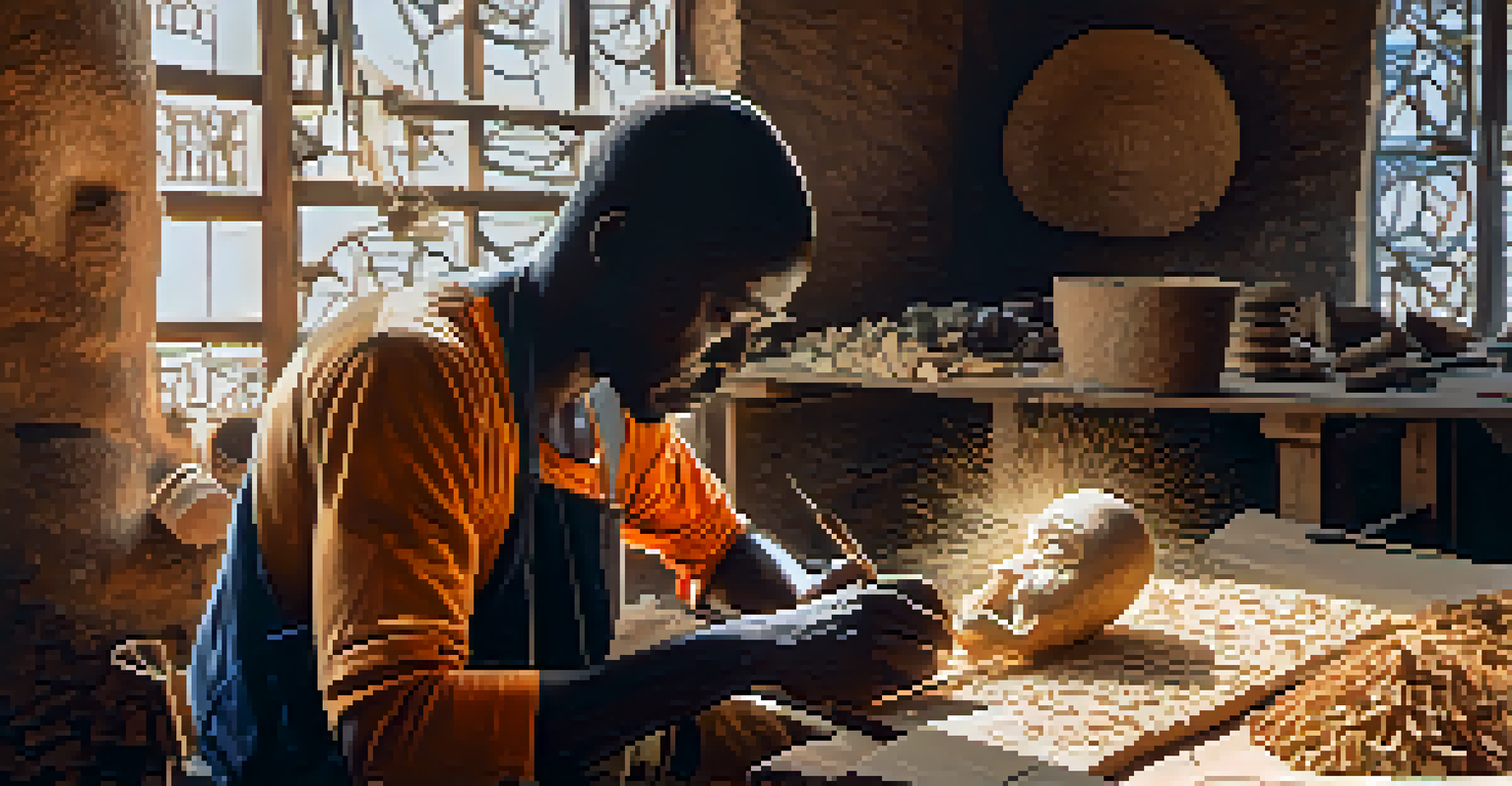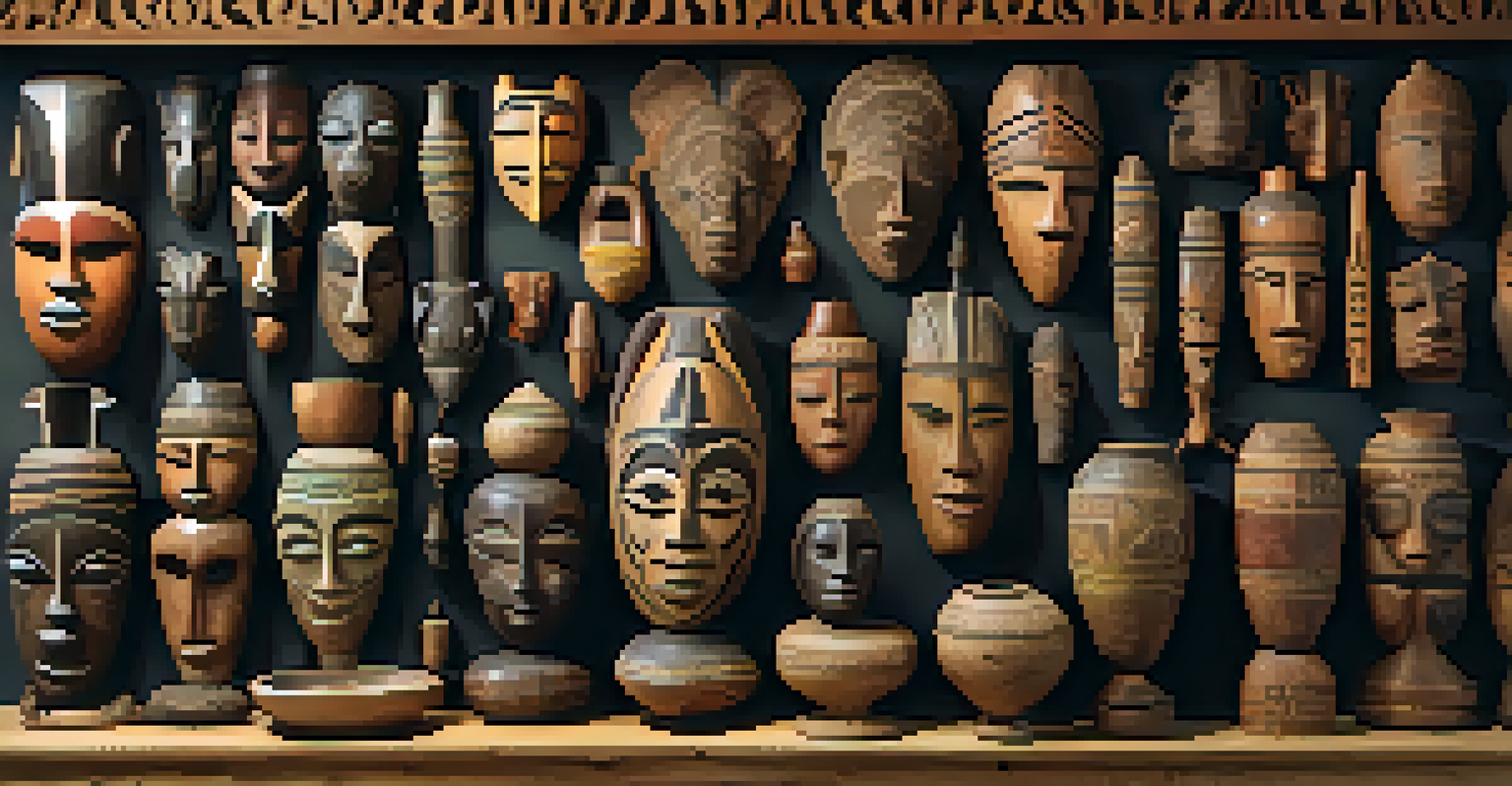African Tribal Carving: Craftsmanship and Spirituality Unveiled

The Rich Heritage of African Tribal Carving
African tribal carving is a vibrant expression of culture, steeped in history and tradition. Each piece tells a story, reflecting the values, beliefs, and social structures of the communities that create them. This art form has been passed down through generations, preserving the intricate skills and meanings behind every carved figure.
Art is the most beautiful of all lies.
Different regions in Africa have unique carving styles and techniques, influenced by local materials and cultural narratives. For instance, the wooden masks of the Dogon people in Mali often symbolize ancestral spirits, while the figurative sculptures of the Akan in Ghana celebrate fertility and lineage. This variety showcases the continent's rich diversity and the importance of oral traditions in shaping artistic expression.
Beyond aesthetics, these carvings serve as vital cultural artifacts that help to maintain community identity. As artisans carve, they engage in a dialogue with their ancestors, infusing each piece with spiritual significance that resonates deeply within their communities.
Materials: Nature’s Palette for Carving
The materials used in African tribal carving are as varied as the cultures that produce them. Wood, bone, ivory, and even stone are commonly used, each chosen for its particular qualities and the message it conveys. Hardwoods like mahogany and teak are favored for their durability and beauty, while softer woods are often employed for intricate details.

Artisans often source materials locally, connecting their work to the land and the spirit of their ancestors. For example, the Baoule people of Ivory Coast use local woods to create masks that embody their rich spiritual beliefs. This close relationship with nature not only emphasizes sustainability but also deepens the cultural significance of the work.
Cultural Significance of Carvings
African tribal carvings are rich in cultural narratives, reflecting the values and beliefs of the communities that create them.
Furthermore, the choice of material can symbolize different aspects of life and spirituality. For instance, the use of ebony may represent strength and resilience, while lighter woods might be associated with fertility and growth. This intentional selection adds layers of meaning to the finished pieces.
Techniques: Mastery Passed Through Generations
The techniques of African tribal carving are often learned through apprenticeship, where young artisans shadow experienced masters. This hands-on experience is crucial, as it allows them to develop their skills while absorbing the cultural stories that each carving embodies. The process can take years, ensuring that the artistry remains authentic and rooted in tradition.
Art is a reflection of society, a way for us to explore and understand the world around us.
Common techniques include hand carving with simple tools, like knives and chisels, which have been used for centuries. This method allows for intricate detailing that brings the figures to life. Many carvers also utilize a technique called 'high relief,' where figures protrude from the background, creating a dynamic interplay of shadow and light.
In addition to physical techniques, the creative process is steeped in ritual and spirituality. Many artisans perform ceremonies or offer prayers before starting their work, seeking inspiration and guidance from their ancestors. This connection to the spiritual realm highlights the profound significance of their craft.
Symbolism: Stories Carved in Wood
Symbolism plays a pivotal role in African tribal carving, with each figure or mask representing specific cultural narratives or spiritual beliefs. From fertility to protection, the themes addressed through these carvings are as diverse as the communities they come from. For instance, a carved figure might represent a fertility deity, celebrating the cycle of life.
Colors and shapes also carry meaning; for example, the use of circular forms can symbolize unity and continuity, while sharp angles might represent strength and protection. Furthermore, the placement of certain carvings within a home or community space can enhance their significance, often serving as guardians or reminders of ancestral wisdom.
Materials Connect Artisans to Nature
The choice of materials in tribal carving emphasizes sustainability and strengthens the cultural significance of each piece.
This rich tapestry of symbolism ensures that every piece of art is not just a decorative item but a profound expression of identity and spirituality. Through these carvings, stories are shared, lessons are imparted, and connections to the past are preserved.
Contemporary Influences on Tribal Carving
In recent years, the world of African tribal carving has seen contemporary influences that blend traditional techniques with modern artistic expressions. Many artists are experimenting with new styles, materials, and themes, creating a fusion that appeals to a broader audience. This evolution reflects the dynamic nature of culture, as it adapts and grows over time.
Some contemporary carvers incorporate elements from global art movements, while still honoring their roots. This approach not only keeps the art form alive but also introduces it to new generations who may not be familiar with traditional practices. By embracing innovation, these artisans are ensuring the longevity of their craft in a rapidly changing world.
However, this blending of styles sometimes raises concerns about cultural appropriation and the preservation of authenticity. It's essential for artists to navigate these waters carefully, ensuring that they respect the traditions while also expressing their unique perspectives.
The Role of Tribal Carving in Modern Society
In today's globalized world, African tribal carving continues to hold significant cultural and social relevance. These pieces often serve as a bridge between cultures, showcasing the richness of African heritage to international audiences. Exhibitions and galleries around the world feature tribal carvings, allowing for greater appreciation and understanding of their cultural contexts.
Moreover, the sale of these artworks provides economic opportunities for artisans and their communities. By supporting local craftspeople, buyers contribute to the preservation of these traditional practices while also fostering sustainable development. This economic aspect is crucial in empowering communities and ensuring that the art form thrives for future generations.
Preserving Traditional Techniques
Efforts to document and teach traditional carving methods are essential to preserving the legacy and authenticity of this art form.
The presence of tribal carvings in modern homes and businesses also sparks conversations about identity, culture, and heritage. As people engage with these works of art, they gain insights into the rich narratives and spiritual significance behind them, fostering a deeper appreciation for diversity.
Preserving the Legacy of African Tribal Carving
As globalization threatens many traditional practices, the preservation of African tribal carving is more vital than ever. Organizations and communities are working tirelessly to document techniques, stories, and cultural significance to ensure these legacies are not lost. Workshops, cultural festivals, and educational programs play a crucial role in this preservation effort.
Additionally, fostering collaborations between traditional artisans and contemporary artists can create a platform for sharing knowledge and techniques. This exchange not only enriches the art form but also highlights the importance of cultural continuity in an ever-evolving world. Such initiatives encourage a deeper understanding of the artistry behind tribal carving.

Ultimately, preserving the legacy of African tribal carving means valuing the stories, skills, and spiritual connections that define this unique art form. By supporting these efforts, we contribute to a richer, more diverse cultural landscape that honors the past while embracing the future.